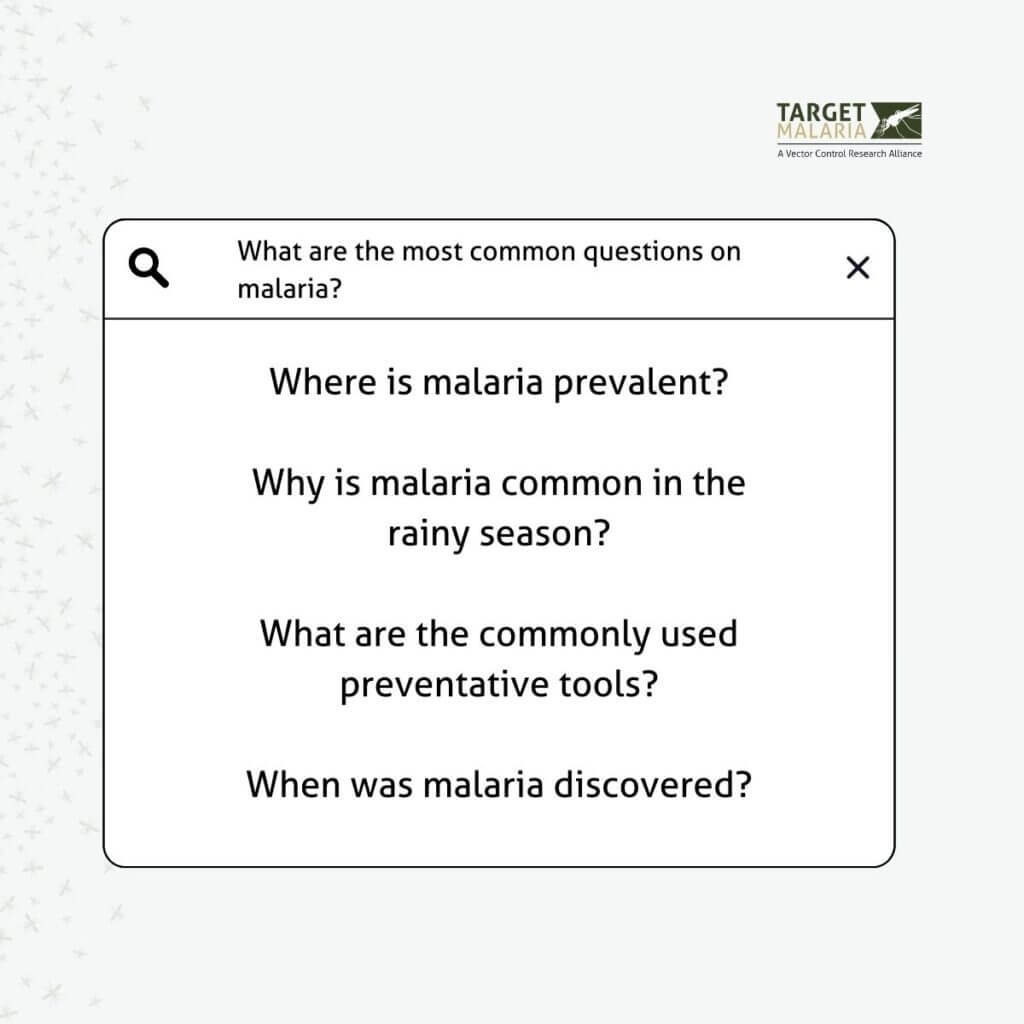What do you need to know about malaria?


In this blog, we answer some of the commonly asked questions about malaria, one of the oldest diseases in the world. Using the tool “Answer the public”, we compiled commonly asked questions on this topic. Answer The Public is a tool used to find the most asked questions using key words. Searching the word “malaria” brought up the below questions.
1. Where is malaria prevalent?
With roughly half the world’s population at risk, malaria is prevalent in large areas of Africa (mostly in Sub-Saharan Africa), South and Southeast Asia, the Caribbean, South America, the Middle East and Oceania. This is because Anopheles, the malaria transmitting mosquito species, thrive in warmer temperatures.
According to the WHO Malaria Report 2022, the Sub-Saharan African region continues to carry the largest share of the world’s malaria burden with 95% of all malaria cases and 96% of deaths.
The 12 countries with the highest number of malaria cases in Africa are Nigeria, Congo, Uganda, Mozambique, Angola, Burkina Faso, Niger, Tanzania, Mali, Ivory Coast, Cameroon and Ghana.
2. Why is malaria common in the rainy season?
Areas with heavy rainfall create breeding grounds for malaria-carrying mosquitoes which lay their eggs in standing water. This can be in puddles, brick pits, tyre tracks, hoof prints and wells. In many countries of the Sahelian region such as Burkina Faso, June to September is when they experience the rainy season. In equatorial region such as in Congo or Cameroon, mosquito abundance is more well spread across the year because of the distribution of rainfall and the existence of two rainy season per year. In general, the peaks are observed around August – October.
However, malaria mosquitoes are rapidly evolving, and species have different preferences. As WHO reported, the Anopheles stephensi mosquito prefers human-made water containers, allowing it to survive all year around and stay active in the dry season. You can read more about the An. stephensi in this blog by Patience Arinaitwe.
3. What are the commonly used tools to prevent malaria?
There are several preventative measures already being used to prevent malaria by individuals such as mosquito bed nets (preferably long lasting insecticide-treated nets), indoor residual spraying, clothes that cover most of the body, and use of insect repellent on exposed skin or clothes, and indoor spraying in homes. Antimalarial medication is also a prevention tool used by many when traveling or living in countries affected by malaria. Malaria chemoprevention is also a tool used in malaria endemic countries. Seasonal malaria chemoprevention is a highly effective malaria prevention tool in those most vulnerable to the effects of malaria. It involves administering monthly doses of antimalaria drugs to children (usually under 5 years of age) during the peak malaria transmission season. Unfortunately, there is increasing resistance to these tools by both the malaria parasite and mosquito, which is why it is important to continue research into new tools to end malaria.
4. When was malaria discovered?
The disease itself was referenced thousands of years back in multiple Chinese documents, Egyptian papyri, Hindu texts and clay tablets from Mesopotamia. Many communities had knowledge around malaria and were aware of its characteristics.
The malaria parasite was discovered in 1880 in Algeria by Dr. Alphonse Laveran, a French military doctor. In the past, it was theorised that malaria was caused by the bad air “mal aire” (Italian) from marshlands.
The role of the Anopheles mosquito in the transmission of malaria was proven by Sir Ronald Ross in 1897 when he was dissecting the stomach of an Anopheles mosquito. In 1902 he was awarded the Nobel Prize for Medicine “for his work on malaria, by which he has shown how it enters the organism and thereby has laid the foundation for successful research on this disease and methods of combating it.” He pursued his research developing anti-malarial treatments in West Africa.
5. What’s the impact of climate change on malaria?
A recent paper published in The Lancet noted that with temperatures higher for longer, there are more suitable months for malaria transmission. Higher temperatures and increased rainfall could affect the behavioural, developmental and distribution pattern of insects like mosquitoes, implicating the control of insect-borne diseases like malaria. Studies warn this has the potential to increase the opportunities for malaria transmission in malarious areas, but also in areas where transmission was previously controlled and in non-malarious areas. A World Bank report shows that by 2050, climate change may cause some unexposed areas to be at risk of malaria transmission, including parts of China, South America and sub-Saharan Africa.
You can also read more in this blog by Jane Namunane Wakikona.
6. Who is most affected by malaria?
Children under 5 years of age are the most vulnerable group affected by malaria, as they have yet to develop immunity to the parasite as well as pregnant women who’s immunity is decrease by pregnancy.
